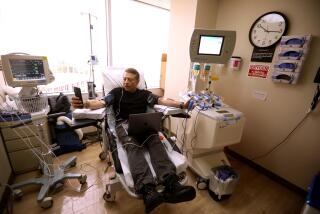A Joint Venture That Paid Off With Less Pain, More Mobility
- Share via
Who expects a new lease on life at 72? I didn’t until two hip replacements allowed me to walk without pain for the first time in 10 years. My wheelchair worries over, I’m making travel plans instead.
“It’s not your knees,” the orthopedic surgeon said, “It’s your hips. They’re totally destroyed.” I came to him complaining of bilateral knee pain that was closing in on me. Now I learned arthritic deterioration of these big ball and socket joints was masquerading as a knee problem--the phenomenon of reflected pain.
The doctor manipulated my legs, suspected hips were the culprit and had X-rays taken that confirmed it. “You need replacements,” he advised. “You should have had them a long time ago.” Amen, I thought. I knew something was terribly wrong. Pain and stiffness were so oppressive I was barely functioning. I worried what would become of me.
Having had 10 surgeries in my adult life, I wasn’t looking for more. The physician began writing information for the surgery request. I stared dumbly at his moving pen. It was like a double whammy when he explained the procedure was life-threatening because of risk of infection, pneumonia and blood clots. I just wanted to leave this place fast!
On the way home I began feeling relief. Here was the answer to the disablement that had me against the wall. It was time to stop being so hard on myself, demanding that I shape up somehow. These operations are major--but I had no choice. The decision was made to tackle the more painful left hip first.
*
I read the brochure on hip replacement surgery but needed mental images. If hardware was to be implanted in me, I wanted to know what it looked like. I wanted to know how the orthopedist would scoop out the old and put in the new. Knowing that more than 350,000 hip replacement surgeries are done worldwide each year didn’t lessen my fright the morning of my operation. When it’s you, statistics don’t matter.
In a hospital bed, I was wheeled in and parked in a holding area outside the operating rooms. When the anesthesiologist asked me to arch my back for the epidural block, the surgeon took my hand and held it. He must have seen trembling and recognized fear as he helped wheel my bed into the brightly lit and chilly operating room.
I knew that hip replacement surgery is a noisy and messy process. A chisel and mallet are used to carve the cavity in the thigh bone where the prosthetic stem and ball will fit. But I heard none of this, being in “la-la land.”
When I awakened in the recovery room, toasty warm blankets were being piled onto me to help raise my blood pressure, which had plummeted from blood loss. I also received a blood transfusion, this time from blood recycled during surgery. After my painkilling medication stopped, there was no postoperative pain as long as I didn’t move: A pillow positioned between my legs minimized shifting around. Only when two physical therapists appeared to take me for the first walk (using a walker) did my body remember it was cut into two days before. They lifted my feet and swung them to the side of the bed. I let out a howl that surprised even me. That 8-inch incision held together with 22 staples wasn’t there for nothing.
*
Transferred to a convalescent hospital for the next two weeks, I received more physical therapy and nursing care that included two daily blood thinner injections in the abdomen. Later, a therapist worked with me at home, and my husband, Dorian, took me to the mall each day for walking practice. What a thrill to see the X-ray, taken six weeks after surgery, showing the bone already growing around the implant.
All arthritic pain was gone from my left side. With one hip fixed, I now slipped in and out of bed effortlessly, compared to pre-surgery days when these maneuvers took some doing. Things were definitely easier than before but, with cartilage gone, my right hip was down to bare bones with the ball grinding in its socket as I moved. Constant hurting kept me exhausted.
The surgeon told me that some patients are so relieved after one hip replacement they don’t bother with the other. I wavered. Who wants to go through this again? Then I reasoned, why settle for half a job? Why not do it right and give yourself the best chance?
Knowing what to expect this time, the second surgery experience was easier. I began preparing for my second surgery about 10 months after the first, making meals to freeze and potting colorful plants to cheer me when I returned home.
All went well. In a few weeks, all traces of pain vanished from both hips. I walked without the limp and waddle of recent years. I could sleep normally again, and I got reacquainted with the energy and endurance that comes from a good night’s rest.
Facing the surgeries, I hoped for improvement but never dreamed it would be so good. Thanks to modern technology, the skill of a master surgeon, the rehab team and a husband who took over at home--including the pesky task of putting elastic stockings on me each morning--I have this second chance and intend to use it well. Having come so close to losing out, I can’t take any of it for granted.
More to Read
Sign up for Essential California
The most important California stories and recommendations in your inbox every morning.
You may occasionally receive promotional content from the Los Angeles Times.













